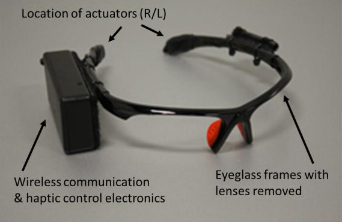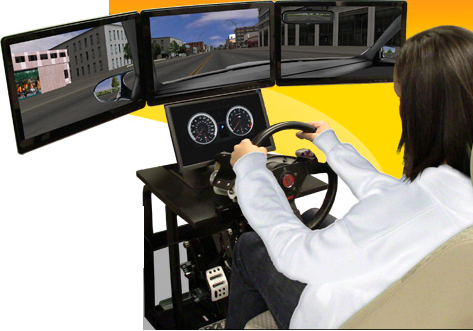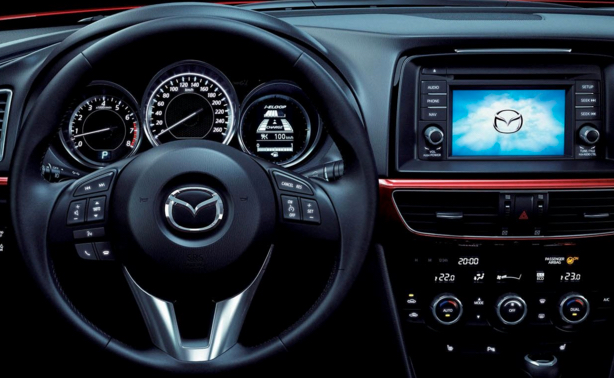Less-distracting haptic feedback could make car navigation safer than GPS audio and displays
February 15, 2016

Vibrotactile actuators in prototype smart glasses (credit: Joseph Szczerba et al./Proceedings of the Human Factors and Ergonomics Society)
Human factors/ergonomics researchers at General Motors and an affiliate have performed a study using a new turn-by-turn automotive navigation system that uses haptic cues (vibrations) to the temples to communicate information to drivers on coming turns (which direction and when to turn), instead of distracting voice prompts or video displays.
They modified a prototype smart-glasses device with motors in two actuators (on the right and left side of the head) that buzz to indicate a right or left turn and how far it is, indicated by the number of buzzes (1 at 800 feet away, 2 at 400 feet, and 3 at 100 feet).

National Advanced Driving Simulator (NADS) MiniSim software (credit: NADS)
Using a driving simulator, each participant drove three city routes using a visual-only, visual-plus-voice, and visual-plus-haptic navigation system. For all three system modalities, the participants were also presented with graphical icons for turn-by-turn directions and distance.
Sample turn-by-turn direction icon (credit: Joseph Szczerba et al./Proceedings of the Human Factors and Ergonomics Society)
The researchers found that effort, mental workload, and overall workload were lowest with the prototype haptic system. Drivers didn’t have to listen for voice instructions or take their eyes off the road to look at a visual display. Drivers also preferred the haptic system because it didn’t distract from conversation or audio entertainment.
The results indicate that haptic smart-glasses paired with a simplified icon-based visual display may give drivers accurate directional assistance with less effort.

Mazda 2015 with GPS audio and video display (credit: Landmark MAZDA)
As noted in “Up to 27 seconds of inattention after talking to your car or smartphone,” two studies by University of Utah researchers for the AAA Foundation for Traffic Safety found that a driver traveling only 25 mph continues to be distracted for up to 27 seconds after disconnecting from highly distracting phone and car voice-command systems. The 27 seconds means a driver traveling 25 mph would cover the length of three football fields before regaining full attention.
According to the Multiple Resource Theory developed by Christopher D. Wickens in Theoretical Issues in Ergonomics Science (open access), multiple tasks (such as use of navigation systems while driving) performed via the same channel can result in excessive demand that may increase cognitive workload (and risks of an accident).
The new human factors/ergonomics haptics research was conducted by Joseph Szczerba and Roy Mathieu from General Motors Global R&D and Roger Hersberger from RLH Systems LLC. It was described in a paper in Proceedings of the Human Factors and Ergonomics Society September 2015.
Abstract of A Wearable Vibrotactile Display for Automotive Route Guidance: Evaluating Usability, Workload, Performance and Preference
Automotive navigation systems typically provide distance and directional information of an ensuing maneuver by means of visual indicators and audible instructions. These systems, however, use the same human perception channels that are required to perform the primary task of driving, and may consequently increase cognitive workload. A vibrotactile display was designed as an alternative to voice instruction and implemented in a consumer wearable device (smart-glasses). Using a driving simulator, the prototype system was compared to conventional navigation systems by assessing usability, workload, performance and preference. Results indicated that the use of haptic feedback in smart-glasses can improve secondary task performance over the conventional visual/auditory navigation system. Additionally, users preferred the haptic system over the other conventional systems. This study indicates that existing technologies found in consumer wearable devices may be leveraged to enhance the user-interface of vehicle navigation systems.